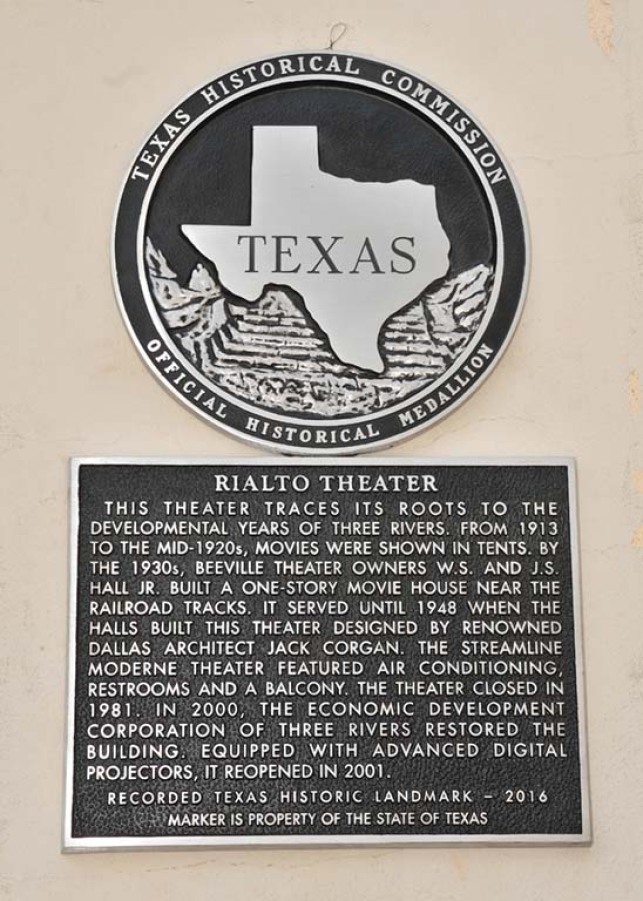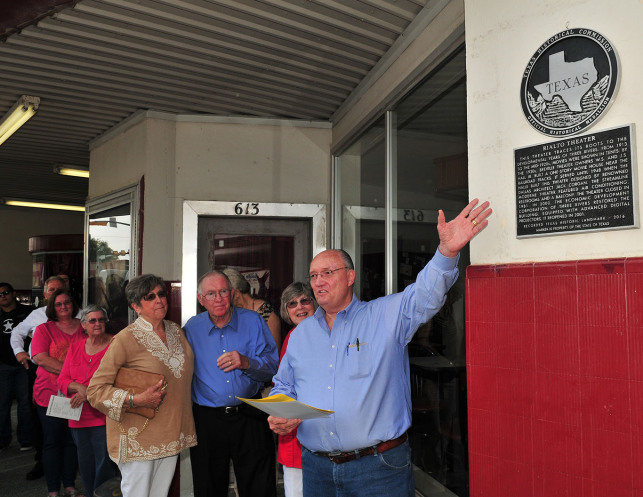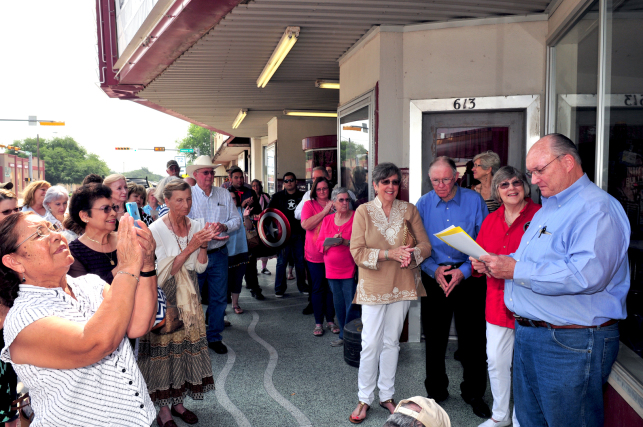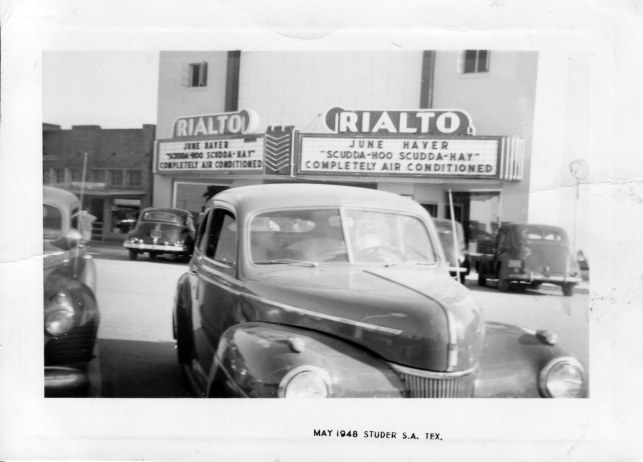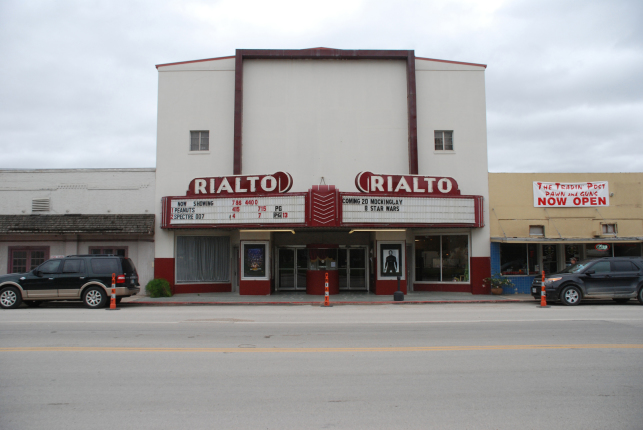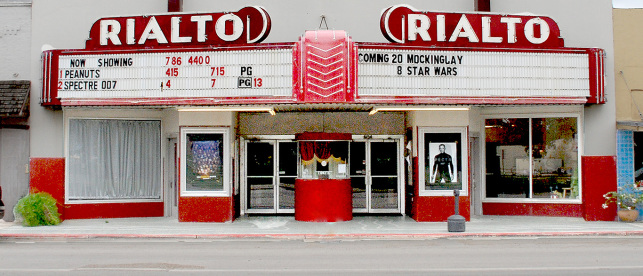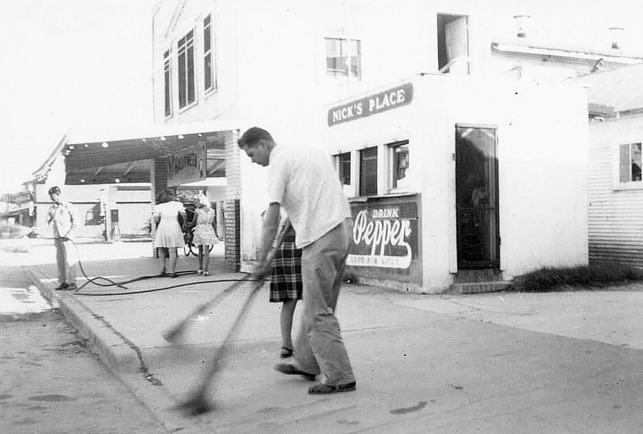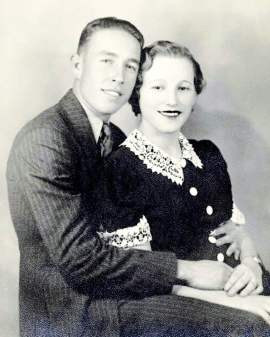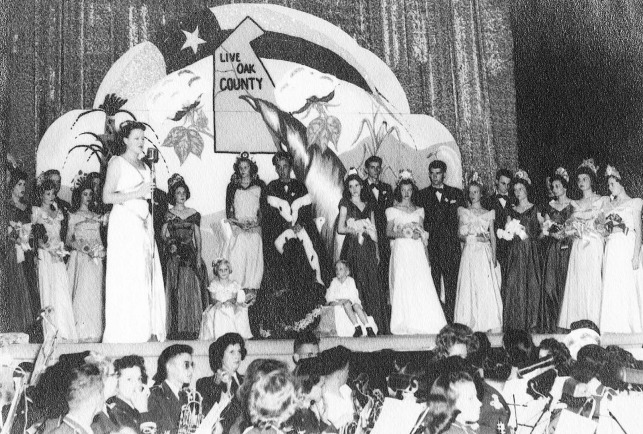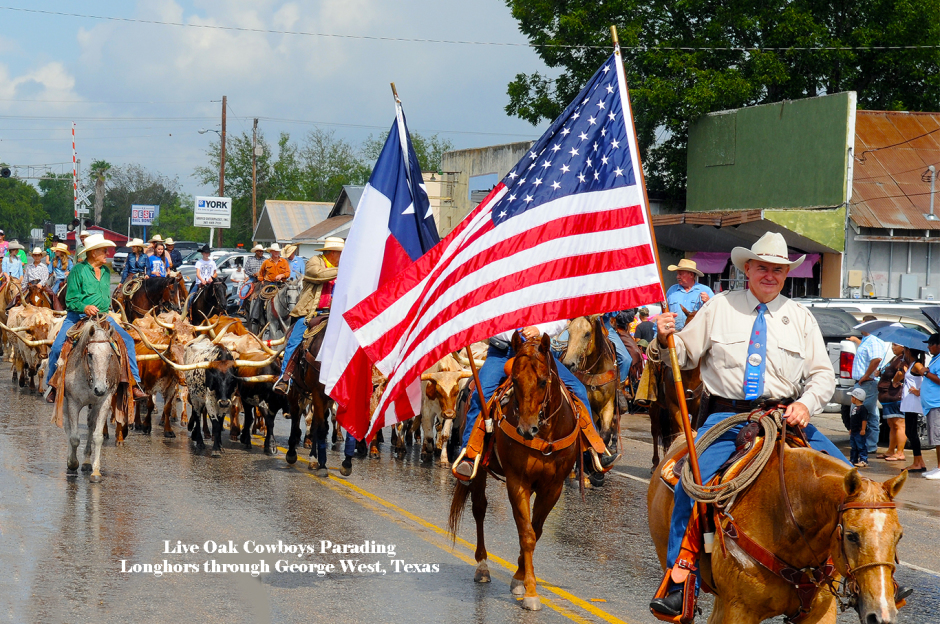
Rialto Theatre Recorded Texas Historic Landmark-Three Rivers
Three Rivers' Rialto Theatre has a long history of entertaining Live Oak County and the surrounding area. From a one story theatre with outdoor employee access only to the second level Projection room, to a mid-century modernized theatre in 1948, and today's restored entertainment center. Photo courtesy Richard Hudson.
Richard "Hud" Hudson, LOCHC Marker Chair, reads the Recorded Texas Historic Landmark Medallion and Marker to the folks gathered after the unveiling of one of their favorite fun places of Three Rivers past. Virginia Herring and staff dressed in period costumes inside serve popcorn and frozen dill pickle juice. Lamar James remembered his friends moving his new VW onto the City Hall sidewalk in the City Park while he and his date and future wife, Tessie, enjoyed a Saturday night date. Photo courtesy John Walker.
1st week-Rialto Theatre- Three Rivers, Texas, opens with "Scudda Hoo Scudda-Hay" starring June Haver, Walter Brennan, Anne Revere, and child actress Natalie Wood. Marilyn Monroe made her debut one liner speaking bit. Photo courtesy Mildred Bellows.
Current Rialto Theatre-Restored in 2001 by the Three Rivers Economic Development Corporation. Photo courtesy Richard Hudson.
Rialto PowerPoint When PowerPoint loads, click on "Start Slide-show" on the top banner. If you wish to move faster, just click on banner at
bottom to forward.
Prepared by Drusanne Hunter, descendant of the Carroll family-original builders of the Rialto and many other buildings throughout Live Oak County.
Live Oak County Judge: Honorable Jim Huff
Live Oak County Historical Commission Chair: Leslie Walker
LOCHC Marker Chair: Richard Hudson
Assistant Chair: Janis Hudson
Rialto Theatre Sponsors: Three Rivers Economic and Development Corporation
Date Unveiled: 2016
Contact: rehudson@liveoakchc.com
Rialto Theatre Recorded Texas Historic Landmark text:
RIALTO THEATRE
THIS THEATER TRACES ITS ROOTS TO THE DEVELOPMENTAL YEARS OF THREE RIVERS. FROM 1913 TO THE MID-1920s, MOVIES WERE SHOWN IN TENTS. BY THE 1930s, BEEVILLE THEATER OWNERS W.S. AND J.S. HALL JR. BUILT A ONE-STORY MOVIE HOUSE NEAR THE RAILROAD TRACKS.
IT SERVED UNTIL 1948 WHEN THE HALLS BUILT THIS THEATER DESIGNED BY RENOWNED DALLAS ARCHITECT JACK CORGAN. THE STREAMLINE MODERNE THEATER FEATURED AIR CONDITIONING, RESTROOMS AND A BALCONY. THE THEATER CLOSED IN 1981. IN 2000, THE ECONOMIC DEVELOPMENT CORPORATION OF THREE RIVERS RESTORED THE BUILDING. EQUIPPED WITH ADVANCED DIGITAL PROJECTORS, IT REOPENED IN 2001. (RECORDED TEXAS HISTORIC LANDMARK - 2016.) MARKER IS THE PROPERTY OF THE STATE OF TEXAS.
APPLICATION NARRATIVE and BIBLIOGRAPHY FOR OFFICIAL RECORDED TEXAS HISTORIC LANDMARK MARKER:
Rialto Theatre – Three Rivers, Texas
I. Context
As the twentieth century began to dawn, technology moved swiftly changing life worldwide. During the late nineteenth and early twentieth centuries most life changing technological advances were made in the motion picture industry. For instance, in 1890, William Kennedy Laurie Dickson, working with Thomas Alva Edison, built the first motion-camera and named it the Kinetograph.1 Then in 1892, Edison and Dickson built a vertical-feed motion picture camera using 1½ inch film strip which they augmented into the international commercial standard 35 mm film by 1909.2
Short scenes usually less than a minute were viewed standing in arcades and at special events where patrons paid five cents to look into individual viewers or “peep shows”. These evolved into the first type of indoor exhibition space dedicated to showing projected motion pictures. Converted storefronts became indoor theaters, called Nickelodeons – a name fabricated from “nickel”, the U.S. five cent coin, and the Greek word “odeion”, a roofed-over theater. These hugely popular venues used gaudy posters and ornamented facades to attract patrons.3 The glitter and tantalizing advertising outside belied the bare walls and hard seats inside, but at least people could sit. Despite the austere inside, the Nickelodeon became the rage in America from about 1905 to 1915.4
During that same time, the emerging industry was developing abroad. The French Lumiere Brothers designed and developed their motion picture camera called a cinematography in 1895.5 One of the world’s first film studios, The Limelight Department, in Melbourne, Australia produced a series of thirteen films and perhaps the first full-length film in 1901.6
Possibly the first dedicated motion picture theatre was in West Philadelphia, Pennsylvania. Film pioneer Sigmund Lubin began with one small building on an esplanade and rapidly expanded into an empire. Lubin was gifted in predicting public interests and marketing; he was plagued by the rapidly changing cinema technology and growing audience sophistication.7 Today, this pattern of change in technology and audience desire continues to challenge the industry.
II. Overview
Three Rivers, Texas founded in the early twentieth century, 1913, by nineteen-year-old Charles R Tips shortly after graduating from the University
of Texas offered opportunity to generations of immigrants from Europe and the American East to own land. They came in wagons, on the train, and on horseback. Few had automobiles, but they were aware and ready to move with the times as the vast nation grew more accessible with the coming of the railroad. Tips offered property and hope in a promising area of rich farm soil at the confluence of the Frio, Atascosa, and Nueces Rivers.8
A convening of hardy and eager folks ready to build and grow together bought designated lots in the fledgling town or bought farms and ranches surrounding the town. They brought trades and agrarian experience while Tips sought merchants, a newspaper editor, a doctor, educators, and other citizenry to support the growing population. Tents with wooden floors were their first homes until permanent houses could be built. Though crude and small, these tents kept out pests and rattlesnakes, rain or viscid black dirt depending on the weather, and flaps allowed costal breezes through to make the hot, humid days of spring and summer a bit more tolerable.9
In those early days, Three Rivers seemed a long distance away from large cities like Corpus Christi, Laredo, and San Antonio because of poor roads and developing transportation. The close knit people sought education for their children and entertainment in the midst of their arduous labors. Movies provided one of the main outlets. In the beginning, they were shown in a tent much like the temporary homes the people lived in.
The first Three Rivers’ Rialto Theater was built by W. H. Hall and J.S. Hall, Jr. of Beeville, Texas. They purchased lots down by the railroad tracks and built the first theater, a one-story vernacular building. Like many theatres of its day, the floor sloped so that viewers could see over the heads of those in front with the projector at the very back above the audience.
A family culture built around the theatre and its movies. Children of all ethnic groups, often bare-footed in the summer, paid ten cents to get into the movie. They loved to sit on the floor in front of the stage with legs crossed, eating a ten cent bag of popcorn and sipping a nickel coke. They never spent more than a quarter for the movie and treats, but they still saw a movie if a dime was all they had.10
Before Jesse Moreno died, he shared how the children laughed and cheered at the latest cartoon or cowboy shoot’em-up. Parents felt their children were safe and often used the theatre as a baby sitter. Teens sat in the very back seats with their dates, taking advantage of time away from their parents. Movie time at the theatre was also family and social time and many families went several times a week as the movies changed out.11
The accoutrements offered at this theater were more rudimentary than later ones. There was no air conditioning, and indoor restrooms were not available. Since the projection room was at the back above the heads of the audience, projectionists carrying reels for the week’s showing climbed a stairwell outside in every kind of weather to enter the projection room. “Popcorn and drinks were sold just outside the entrance at a stand labeled Nick’s, though everyone called it ‘Mom’s and Pop’s’ after the elderly couple that ran it.”12
In June of 1948, the Hall’s opened a new Rialto several streets to the east of the old theatre.13The Halls having owned twenty-two theaters in the South Central Texas Area by this time presented their patrons with greater comfort and movie sophistication.14
Jack Corgan, a well-known Dallas architect, was chosen to design the new Rialto and the architectural style he used was Streamline Moderne, a transition between Art Deco and Modern architecture. Jack Corgan founded his own firm in 1938. He was one of the first ten professional architects to pass state licensing. Corgan designed 57 theatres. Caught between changing technology and audience preferences for upgrades, numerous of those theatres are now closed. Only seven have been renovated structurally and digitally and are still showing films today. The Three Rivers Rialto is one among these seven.15
Streamline Moderne used by Corgan to design the Rialto probably had much to do with timing. Art Deco was passing, and an extreme passion for modern straight lines was developing as the nation moved into the 1950’s. Characteristics of Streamline Moderne incorporated into the Three Rivers’ Rialto are horizontal orientation, smooth stucco exterior finish, dark burgundy trim contrasting with subdued base cream color, and the incorporation of neon lighting on the marquee.16
The Halls then hired Joe Jones, who had served in the Pacific during WWII, to manage the new Rialto in Three Rivers, Texas. Jones learned the entertainment business from his father, Tex Jones, who owned a rodeo circuit. Under Jones management and publicity moxie, the Rialto served the people of Three Rivers and Live Oak County with first run movies, pageants, and other community extravaganzas. The opening day first run movie was “Schudda Hoo Schudda Hay,” in which Hollywood newcomer Marilyn Monroe had her uncredited first one-liner appearance as Betty.17
The new air conditioned Rialto, had convenient indoor restrooms, a balcony, a fully stocked concession, and the very latest in movie projection technology. The air conditioning alone drew crowds, especially during spring and summer months. Most of their homes were not equipped with the latest in cooling technology. Virtually every kid in town went to the movies on Saturdays to stay cool, watch a good western or war movie, cartoons, and news reel while parents stayed home and enjoyed a much needed rest from child rearing.
The Hall’s Rialto enjoyed its status as a social center though television and other local venues grew and challenged the once thriving control theatres enjoyed. Finally, in 1981, the family closed the theater and moved Joe Jones to another theater it owned in Beeville. The Three Rivers Rialto theater went through a series of owners before the Economic Development Corporation purchased, renovated, and began leasing the theater to entrepreneurs.18
The Economic Development Corporation (EDC) of Three Rivers, Texas, purchased the theater November 6, 2000, from Juanita Chapa, whose husband passed the theater to her in his will. The EDC restored the exterior to the original Streamline Moderne majesty, replaced the projection equipment with the latest in digital projection technology, and in 2001 leased the theater to an entrepreneur.19 Today, under a new lessee the Rialto continues to provide first run movies to a three county clientele.20
At one time there were 57 Corgan-designed theaters. Seven theaters are still open today, the Three Rivers Rialto is among the seven and continues to provide first run movies to a three county area.21
III. Significance
Shortly after the first settlers moved into Three Rivers, Texas, and began building homes and businesses, a movie tent followed. It provided entertainment and news from the outside world to railroad workers and the settlers populating the new town and countryside.
Movie tents provided movies and news from the outside world until a permanent, one-story vernacular theater was built in the 1920’s. The first Three Rivers' Theater served the community until May 1948. The old theatre served the needs of the community for entertainment and more during all those years.
Even though the old theatre may have been an entertainment hub, the new one was even more so as it exposed the viewing public to the latest venues for ideas and opinions on emerging Hollywood genres, emerging actors and actresses, cartoons, serials, war, latest technology, science, and politics. Not only did it provide entertainment and ideas, the theater also provided jobs for the young. Many a kid developed social skills and an acute sense of responsibility working at the Rialto.
A family culture evolved around both the old and new theatres. Children found delight in the cartoons and trending films. The place was a safe haven for them as work weary parents relaxed either at the theatre or home. Often families came together. Teens sought independence and relative privacy first in the upper back of the old theater and then the balcony of the new one. Special events drew audiences from far and wide. Later television, an acceleration in school activities, and other social venues in the town led families to rely less and less on the theater.
It appeared that the Rialto closed forever in 1981. However, it was soon purchased and reopened under new ownership.
The Economic Development Corporation of Three Rivers, Texas, finally purchased the theater in 2001, restored the exterior to its original Streamline Moderne grandeur, replaced the projection equipment with the latest in digital projection technology, and leased the theater to an entrepreneur. Today, under a new lessee the Rialto continues to provide first run movies to a three county clientele. It is only one of seven Corgan-designed theaters still operating today from the 57 originals designed by Jack Corgan.
IV. Documentation
1 Tim Dirks. “Timeline of Greatest Film Milestones and Turning Points in Film History,” AMS Filmsite. http://www.filmsite.org/milestonespre1900s_2.html on November 3, 2015, accessed November 30, 2015.
2 Ibid.
3 “This Day in History”. History.Com. http://www.history.com/this-day-in-history/first-nickelodeon-opens, accessed November 3, 2015.
4 “Nickelodeon (movie theater), Wikipedia, The Free Encyclopedia, https://en.wikipedia.org/wiki/Nickelodeon_(movie_theater), accessed November 30, 2015.
5 Plopoku in History. http://www.timetoast.com/timelines/technological-advancements-1750-1900--3, accessed November 3, 2015.
6 Dirks. Ibid.
7 Montgomery County Community College. “Betzwood”. https://mc3betzwood.wordpress.com/, accessed November 3, 2015.
8 Ervin L. Sparkman. The People’s History of Live Oak County, Texas. Mesquite: Ide House. 1981. 137-169.
9 Richard and Janis Hudson. Images of America-Live Oak County. Charleston: Arcadia Publishing. 27-64.
10 Carolina Quintanilla, interview by Richard Hudson in her Three Rivers home, April 24, 2012.
11 Betty Dickinson interview by Richard Hudson, phone, recorded, November 23, 2015.
12 Hudson. Ibid. 50.
13 DR 117/128, DR 119/247-8, DR/Lease Agreement 587/13
14 George West Attorney Tommy Forehand in conversation with Richard Hudson. Forehand worked in the old and new Rialto Theaters back in the 40s and 50s.
15 Cinema Treasures. “Movie Theatres Designed by Jack Corgan.” http://cinematreasures.org/architects/562, accessed November 24, 2015.
16 http://www.wsj.com/articles/from-streamline-moderne-to-modern-1427980494, accessed November 25, 2015.
17 “Scudda Hoo! Scudda Hay! Full Cast & Crew,” IMDb. www.imdb.com/title/tt0040762/fullcredits, Accessed November 30, 2015.
18 Deed, Vol. 576, pg 364, Live Oak County Clerk’s office, George West, TX.
19 Economic Development Corporation Articles of Incorporation, i.e., Certificate of Incorporation from the Secretary of the State of Texas, March 24, 1986.
20 Author in conversation with Virginia Herring, current Lessee of the Rialto Theater, 361- 492-9205.
21 Cinema Treasures. “Movie Theatres Designed by Jack Corgan.” http://cinematreasures.org/architects/562, accessed November 24, 2015.
Rialto Theatre - A Three Rivers Legacy
Adpated from the Progress, April 4, 2017 by Richard and Janis Hudson.
The Rialto Theater in Three Rivers has been designated a prestigious Recorded Texas Historic Landmark (RTHL) by the Texas Historical Commission (THC). According to
Drusanne Hunter, County Historical Commission (CHC) appointee and Unveiling Committee chair, an official public ceremonial unveiling of the RTHL marker will occur at
the Rialto Saturday, April 29, 2017 at 10 a.m.
Ross Harris, Live Oak County Historical Commission (LOCHC) chair, encourages all Three Rivers and county folks to attend the unveiling. “Really, this is great news,” says Harris. “One thing modern multiplex theaters cannot give is a feeling of community. As a kid, I identified with the theaters. Friends gathered for the latest flicks, with dates, for news or local scuttlebutt. And the popcorn and Cokes. It was a super feeling.”
Virginia Herring, current Rialto manager, worked tirelessly with Drusanne Hunter, Nancy Coquat, Cindi Robinson and other LOCHC appointees. They developed a
momentous
community unveiling ceremony for the RTHL recognition.
The first Rialto, one-story for patrons. A second attic level housed the projection room and storage. Entrance to that level was only through an outside stairwell. This first Rialto was located west of the current Rialto on the same side of Thornton Street near the old railroad depot. It was built in the later 1920s and early '30s and shut down after the new Rialto opened May 1948. Photo courtesy Elmo Hartman.
Back in the late 1920s, W.H. Hall and J.S. Hall Jr. of Beeville built the first Three Rivers
Rialto on Thornton Street near the railroad depot – an exciting step up from movies in
makeshift tents. Then in 1948, the Hall brothers built a newer modern Rialto.
Pieces of foundation are all that remain of the old Rialto. Deceased old-timers, like Joe
Jones, Elmo Hartman, Carolina Quintanilla and Jesse Moreno once reminisced nostalgically
about the first Rialto.
Hartman recalled, “Teens like Jerry Wheeler made money. He carried a big reel in all types of weather up the outside stairwell to the projection room. Next door fresh
popcorn
wafted from Mom and Pop Lee’s hamburger stand, and all it cost a kid was a few cents for
an afternoon of movie bliss.
Carolina Quintanilla remembered sitting barefoot with other children on the big floor in front of the seats that started halfway back. “The theatre was integrated well before the schools. We all loved the adventures of Gene Autry, Roy Rogers, Zorro, Hopalong Cassidy and the Cisco Kid.”
Jesse Moreno, voted "Friendliest Boy" his junior and senior years in Three Rivers High School, said, “Some teens sat in the back with dates. Anyone who needed to be reached outside 8-5 knew to call Gladys, our hometown operator. She would get them at the theatre.”
Lillian Lee, now in a nursing home, fondly remembers how she “drove across the railroad
loaded with our Red and White Grocery Store’s latest fliers. Nine to 12-year-old boys
hitched rides on my car’s running boards for a chance to place the fliers on front door
screens. With the 50 cents I gave, they could take younger brothers and sisters to the movie, maybe even share a Coke, a bag of popcorn or hotdog."
Old memories fade. But the Streamline Moderne Corgan architecture of the new Rialto excited Three Rivers. Cars filled the square day and night
with folks drawn by neon marquee announce- ments of the latest tantalizing westerns and
faraway lands. Three Rivers became a destination even for flyboys from Beeville.
Folks sought relief from summer’s blazing heat, enjoyed a movie, ate popcorn and drank a nickel Coke once a week or more. Movies changed every other day. At 25 cents for
adults and 9 cents for children, it was an affordable luxury.
Joe and Lorain "Jonesy" Jones worked together as managers of the Rialto and the next door confectionery not long after it opened.
(Photo courtesy Joe Jones.)
Joe Jones came from a long line of showmen. Before movies entered small South Texas towns, rodeos were the big show. Jones father, Tex Jones, and his mother, Zula, produced a traveling rodeo and horse races across Texas. Jones recollected, “When I was old enough to sit in the saddle for rodeo photos, my dad said, ‘Son, smile like a jackass eating prickly pear.“ Joe’s natural entrepreneurial inclinations and sense of humor inherited from his dad were great assets.
Cokes were still 5 cents and Gladys still called, but everyone sat in velvet cushioned seats,
teens in the balcony, more jobs than before, and Jones and his wife, “Jonesy,” ran a confectionary next door.
Joe Jones worked with civic organizations, the county and city promotional events such as the 1948 Live Oak County Pageant. He made the Rialto an integral part of community activities. Photo courtesy Joe Jones.
Under Jones’ 20-year guidance, the Rialto hummed as a local social hub. Civic organizations as well as the city developed promotional events in the theatre. Beauty
contests, talent shows and other venues often included drawings with door prizes.
Businesses from Three Rivers and all over liked the advertising. Prize donations included B-B guns, toy telephones, musical instruments and similar childhood interests. Adults won
w e s t e r n wear, hardware tools, small kitchen appliances and gift certificates for dining or services.
By the late 1980s, the Rialto went into decline, but thanks to the foresight of the Three Rivers Economic and Development Corporation in 2001 directed by Honorable Jim
Huff, the Three Rivers Rialto Theatre is preserved for posterity.
Today, under Herring’s management, the Rialto is seeing resurgence in community interest.
Richard Hudson, marker chair for the LOCHC, said, “A building must be at least 50 years old, have remained in the same location, relate compelling county history, and
maintain its original significant architecture to receive this honor from the State of Texas. The Rialto fits easily within those parameters.”
On Saturday, April 29, at 10 a.m., the public is invited to celebrate the history of the Rialto Theatre and Three Rivers. For more information, go to www.liveoakchc.com. for more information about the Rialto and Live Oak County.
The Live Oak County Historical Commission (LOCHC) is an arm of the county government under the oversight of County Judge, Honorable Jim Huff and chaired by Ross Harris,
president of SouthTrust Bank in George West. Volunteer members of the LOCHC are appointed by the Commissioner’s Court every two years and must demonstrate an active interest in preserving Live Oak
County history.
